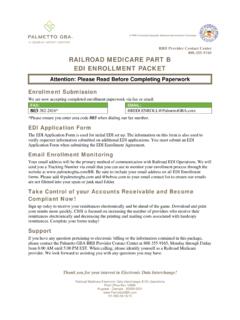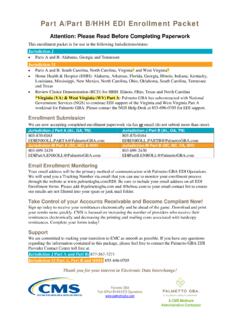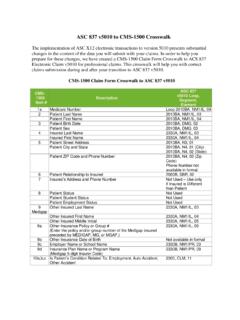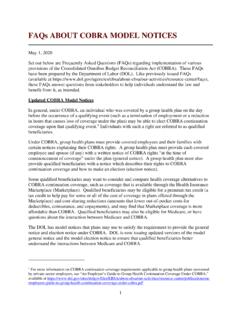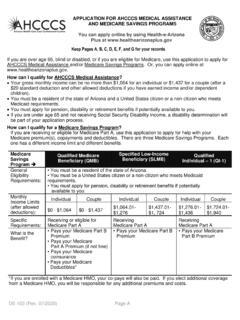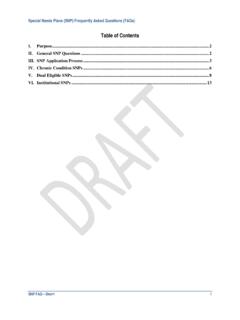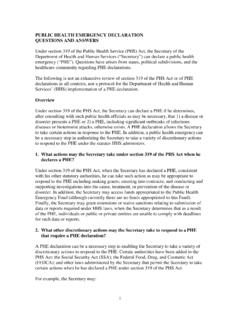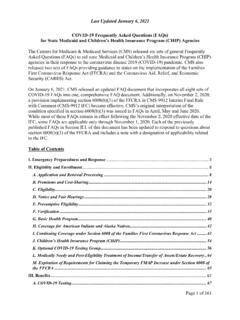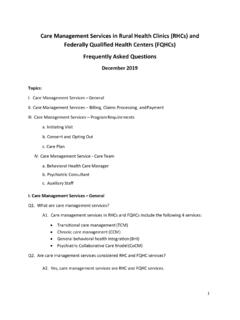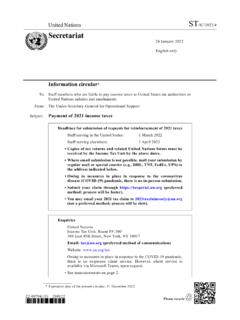Transcription of Hospice General Inpatient Care (GIP) - Palmetto GBA
1 Hospice General Inpatient Care (GIP). 1. Using On24 Widgets Use your mouse to point, click and open a widget Minimize/Maximize a Widget Survey 2. Close any unneeded browser windows or programs to improve sound quality and transition of slides. 3. Disclaimer The information provided in this handout is current as of August 13, 2019. Any changes or new information superseding the information in this handout will be provided in articles and publications with publication dates on or after August 13, 2019. The information will be posted at CPT only copyright 2019 American Medical Association. All rights reserved. The Code on Dental Procedures and Nomenclature is published in Current Dental Terminology (CDT), Copyright 2019 American Dental Association (ADA). All rights reserved. 4. Please take a moment to use your widget and complete the pre-test Pre-test Agenda Hospice Levels of Care Background of GIP.
2 Palmetto GBA's initiative GIP Documentation Requirements Billing Reminders Question and Answers 6. Levels of Care Routine Home Care (RHC): is paid the routine home care rate for each day the patient is under the care of the Hospice Continuous Home Care (CHC): is paid the continuous home care rate when continuous home care is provided in the patient's home. This rate is paid only during a period of crisis and only as necessary to maintain the terminally ill individual at home. Continuous home care is not intended to be used as respite care. Inpatient Respite Care (IRC): Hospice is paid at the Inpatient respite care rate for each day in which the beneficiary is in an approved Inpatient facility and is receiving respite care. Payment for respite care may be made for a maximum of 5 continuous days at a time including the date of admission but not counting the date of discharge.
3 General Inpatient Care (GIP): Hospice has a per day per diem and is only provided at a medicare certified Hospice facility, hospital or skilled nursing facility 7. What is GIP? GIP care is: Short-term care that provides pain and symptom management that cannot be accomplished in another setting GIP may be provided in a medicare participating hospital, skilled nursing facility (SNF) or Hospice Inpatient facility 8. GIP Initiative To determine potential causes for extended lengths of stay for GIP. Palmetto GBA compiled comparative billing reports (CBRs) based on providers billing for the GIP level of care Letters were sent to all providers We educated provider groups and conducted teleconferences Three primary topics were identified and the goal is to help the provider community to avoid long lengths of stays Evaluation Discharge planning Documentation 9.
4 GIP Coverage Criteria Appropriate GIP include a patient in need of medication adjustment, observation or other stabilizing treatment Providers cannot bill medicare for GIP care days for situations where the individual's caregiver support has broken down unless the coverage requirements for the GIP level of care are otherwise met 10. GIP Coverage Criteria Hospices must be able to deliver GIP to patients who qualify for the service Hospices must either provide it directly in their own Hospice Inpatient unit or they must contract with one of the other acceptable facilities medicare -certified Hospice that meets the conditions of participation for providing Inpatient care directly as specified in medicare -certified hospital or a skilled nursing facility that also meets the standards specified in (b) and (e) regarding 24- hour nursing services and patient areas 11.
5 GIP and Hospital Benefit GIP care under the Hospice benefit is not equivalent to a hospital level of care under the medicare hospital benefit A brief period of GIP care may be needed in some cases when a patient elects the Hospice benefit at the end of a covered hospital stay If a patient in this circumstance continues to need pain control or symptom management, GIP can be an appropriate option If a Hospice patient receives GIP for 3 days or more in a hospital and chooses to revoke Hospice , then the 3-day stay would qualify the beneficiary for covered SNF services 12. GIP Discharge Planning Discharge planning begins on admission and continues throughout the GIP stay Patient may remain in a facility, but medicare will not pay for GIP if the medicals records do not indicate a clear need for GIP level of care GIP is not intended to be custodial or residential Once the patient's symptoms are stabilized or pain is managed, he or she must return to a routine level of care 13.
6 GIP Documentation Office of the Inspector General (OIG) reports that more than one- third of Hospice GIP stays lack the following information: Hospice election statements did not include that the beneficiary was waiving coverage of certain medicare services by electing Hospice care or that Hospice care is palliative rather than curative The physician did not meet requirements when certifying that the beneficiary was terminally ill and/or appeared to have limited involvement in determining that the beneficiary's condition was appropriate for Hospice care 14. GIP Documentation Five recommendations to help ensure that your documentation supports the GIP level of care Describe the services provided Identify the precipitating event that led to GIP status Describe failed attempts to control symptoms that occurred prior to admission Identify specific symptoms that are being actively addressed Document care that patient's caregivers cannot manage at home.
7 Some examples are frequent changes in the dose or schedule of medications or the need for IV medications 15. GIP Documentation The pain/symptom management needs being addressed Interventions used to address the needs Patient's response to the interventions and progress toward goals Why the interventions cannot be provided in the home setting Discharge planning 16. GIP Symptom Changes Sudden deterioration requiring intensive nursing intervention Uncontrolled nausea and vomiting Pathological fractures Respiratory distress which becomes unmanageable Transfusions for relief of symptoms Traction and frequent repositioning requiring more than one staff member Wound care requiring complex and/or frequent dressing changes that can not be managed in the patient's residence Severe agitated delirium or acute anxiety or depression secondary to the end-stage disease process requiring intensive intervention and not manageable in the home setting 17.
8 Document the Patient GIP Needs Pain, despite numerous changes to medication Bleeding that would not stop Nausea and vomiting, despite changes to medication Terminal agitation, unresponsive to medication Medication adjustment that must be monitored 24/7. Stabilizing treatment that cannot take place at home Note: Document the patient GIP needs on a daily basis 18. Pain Documentation Pain requiring Frequent evaluation by a doctor or nurse Frequent medication adjustment IVs or transfusions that cannot be administered at home Aggressive pain management Complicated technical delivery of medication requiring a nurse to do calibration, tubing, site care 19. Documentation Tips Discharge planning begins on admission and continues throughout the GIP stay Document the team's efforts to resolve patient problems at the lowest level of care Address discharge plans (or reason why the patient is still appropriate for GIP).
9 Explain why care must be provided in the Inpatient setting instead of at home or SNF ( , patient requires frequent RN/NP/MD assessment and titration of medications to control pain ). 20. Documentation Tips Describe the services provided Each note stands on its own in supporting the level of care Identify the context and the precipitating event that led to GIP status Describe failed attempts to control symptoms that occurred prior to admission Document care that patient's caregivers cannot manage at home ( , frequent changes in medication dose/route/schedule, IV medications). 21. Documentation Tips Identify specific symptoms that are being actively addressed ( uncontrolled nausea/vomiting, new delirium/agitation ). Document progress/context/changes including symptomatic imminent death that cannot be managed at home Document patient's responses to interventions in the GIP.
10 Setting Were they effective and are they still effective? 22. Scenario One for GIP. 85-year old female with liver cancer and a secondary diagnosis of dementia. Patient is bed-bound. She is incontinent of bowel and bladder and requires personal care throughout the day. Patient is lethargic but arouses to vigorous stimuli. The daughter request that her mother be transferred to an Inpatient unit, she can no longer provide the care that is required. Her medication regimen includes Morphine Sulphate twice daily with sublingual morphine for break-through pain two hours prn. The patient has required increasing amounts of morphine for break-through pain over the past two days. She is having increased periods of agitation and anxiety. The patient begins having grand mal seizures and is started on intravenous medications to control the seizure activity.

